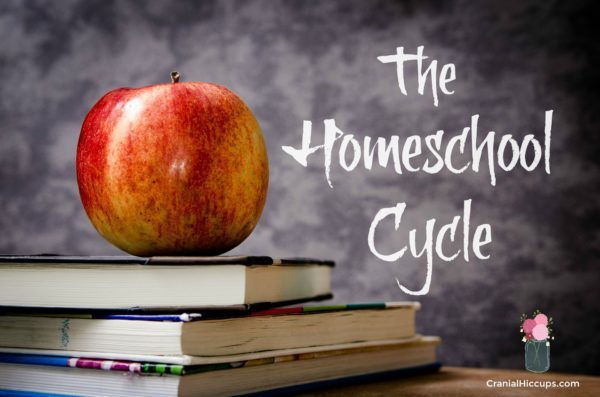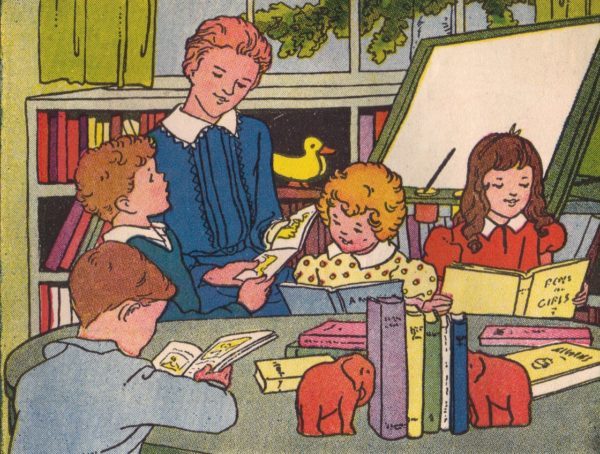
If there’s one thing I’ve learned from studying science, or history for that matter, it’s “Everything runs on a cycle.” In science we learn about the water cycle, the carbon cycle, the cell cycle, etc. Our years are based on seasons that cycle through one after another. History also repeats itself. This is best shown by what we know as the “pride cycle” in the scriptures. So does it surprise you to find that homeschooling also has a cycle?
It goes something like this.
Planning
This stage involves gathering curriculum and supplies, deciding what to focus on with each subject, and scheduling special field trips. It’s researching and asking and being overwhelmed at all that’s available. It’s also praying and listening to what you feel led to do for each child, making sure their specific needs will be met.
If you want a place to start here are some curriculums I recommend. I have either used these myself or have friends that do.
Sonlight – Literature and History based learning using LOTS of books.
Bookshark – similar to Sonlight without the religious references.
The Good and the Beautiful – another good, overall high quality curriculum. The K-5 language arts and literature are available for free!
Implementing

This step is usually approached with much gusto and excitement. New books to read! New art supplies! Lapbooks and unit studies to do!
Everyone settles down into a routine and learning actually takes place. This is where you see the wonder and excitement light up your children’s faces.
Or not.
Sometimes it’s just slugging through and pressing on. Eventually the initial excitement begins to wane.
And then we get to the dreaded “B” word.
BURNOUT
What? You didn’t know that was a natural part of the cycle? You are not the only one to have days (or weeks, or months) with no motivation! I have never met a homeschooling mom who hasn’t hit a roadblock in her homeschooling journey. Maybe teaching the multiplication tables has become a chore, or a much longed for and loved new baby is dealing with colic – interrupting sleep patterns and school days, or winter has really set in with no sunshine to be seen in the forecast for the next two weeks and everyone is getting stir crazy being cooped up in the house. I have experienced each of those scenarios (and much more!) and I bet you have too.
Guess what?
IT’S OKAY!! Burnout is part of the cycle. Knowing this helps us to fight our way out of it so we can spend more time in the other stages of the homeschool cycle.
Here are some helpful tips for facing homeschool burnout:
- Change things up! Sometimes just re-doing your schedule, switching science Fridays with music Mondays is enough to dispel the burnout. If you normally teach one way switch to something completely different for one week. Instead of doing workbooks do a nature study outside. Invite other homeschool buddies over for a co-op lesson.
- Schedule Breaks. This can be as often as taking every other Wednesday off. Or every once in a while declaring the day to be a “Stay in Our Jammies and Read Books on the Couch Together” type of day. It can also be a permanent part of your homeschool schedule. Back in March I wrote about our yearly homeschool schedule of doing six weeks of school, then having one week off. This evolved because after a couple of years of homeschooling I realized spacing out breaks in this manner greatly reduced (notice I didn’t say eliminate!) our burnout periods.
- Talk to friends. Just sharing your struggles with those who understand can help to lift our burden. They can give us ideas for dealing with the burnout. They can also remind us again of why we are doing this!
- Take One Day at a Time. Sometimes that is all you can do! We were reminded of this in the 2011 January CES Fireside by Elder D. Todd Christofferson. After quoting part of the Lord’s Prayer, “Give us this day, our daily bread.” Elder Christofferson said,
“Jesus is teaching us, His disciples, that we should look to God each day for the bread — the help and sustenance — we require in that particular day. The Lord’s invitation to seek our daily bread at our Heavenly Father’s hand, speaks of a loving God, aware of even the small, daily needs of His children and anxious to assist them, one by one. . . Take it one day at a time. The Spirit can guide us when to look ahead and when we should just deal with this one day, with this one moment. To deal with something very big, we may need to work at it in small, daily bites.”
Educating our children is a big task! It is a commitment: of time, of love, of selfless service. Because of our mortal tendencies we will falter. We are so blessed to have a knowledge that with the Lord’s help we can make it through. He will help us!
Help us on to the next phase of the cycle.
Rest
Even the Lord rested after creating the earth. Rest is good for us and our children. Just be sure the rest doesn’t turn into a long period of idleness.
Our rest periods are usually a month long but there are also shorter week long rest periods in the midst of our schooling too. Our schedule is three months on of homeschooling with one month off. In the middle of the three months on we also take a week off. For our family this has really helped us to stay balanced.
I don’t even homeschool and I loved this post. Thanks for sharing the things that work for you, and i really needed to read that quote from Elder Christofferson today.
Oh, Elder Christofferson’s talk was just exactly what I needed today! Thank you!